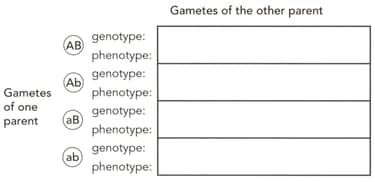Mary Jones, Richard Fosbery, Dennis Taylor and, Jennifer Gregory Solutions for Chapter: Inheritance, Exercise 14: EXAM-STYLE QUESTIONS
Mary Jones Biology Solutions for Exercise - Mary Jones, Richard Fosbery, Dennis Taylor and, Jennifer Gregory Solutions for Chapter: Inheritance, Exercise 14: EXAM-STYLE QUESTIONS
Attempt the practice questions on Chapter 16: Inheritance, Exercise 14: EXAM-STYLE QUESTIONS with hints and solutions to strengthen your understanding. Biology for Cambridge International AS & A Level coursebook 2nd Edition Digital Access solutions are prepared by Experienced Embibe Experts.
Questions from Mary Jones, Richard Fosbery, Dennis Taylor and, Jennifer Gregory Solutions for Chapter: Inheritance, Exercise 14: EXAM-STYLE QUESTIONS with Hints & Solutions
Distinguish between the terms homozygous and heterozygous.
In the sweet-pea plants, the gene A/a controls flower colour. The dominant allele gives purple flower and the recessive allele red flower. A second gene, B/b controls the shape of the pollen grains. The dominant allele gives elongated grains and the recessive allele spherical grains. A plant with the genotype AaBb was test crossed by interbreeding it with a plant with red flowers and spherical pollen grains.
Copy and complete the table to show the expected ratio of phenotypes of the offspring of this cross. The gametes from one parent are already in the table.

With reference to the control of expression of the gene for - galactosidase in Escherichia coli, explain the meaning of operon.
With reference to the control of expression of the gene for -galactosidase in Escherichia coli, explain the meaning of structural gene.
With reference to the control of expression of the gene for-galactosidase in Escherichia coli, explain the meaning of the inducible enzyme.
Explain how the presence of lactose in the environment causes the synthesis of -galactosidase.
Explain why it is advantageous to the bacterium to secrete -galactosidase only when lactose is present.
Thyroid hormones have various functions in the body, including increasing metabolic rate, stimulating growth in young people and increasing the ability of heart muscles to contract. Thyroid hormones are small molecules, based on the amino acid tyrosine, that enter their target cells through carrier proteins. Explain why thyroid hormones enter cells through carrier proteins, rather than diffusing through the lipid bilayer.
